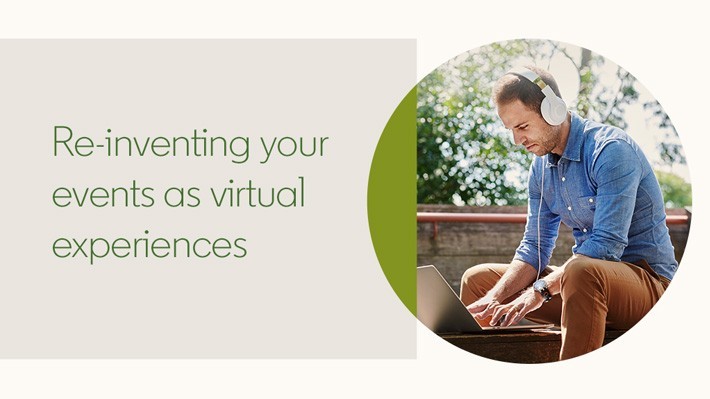Re-inventing your events as virtual experiences
Events have a huge role to play in B2B marketing strategies. However, in these unprecedented times, with people’s health and wellbeing paramount and events cancelled around the world to mitigate the spread of COVID-19, in-person events won’t be able to play that role for some time.
A cancellation or postponement creates a challenge – but doesn’t have to mean that all the work you put into preparing an event is wasted. You may not be able to create the same unique atmosphere that comes from bringing delegates and speakers together in one place. However, re-imagining your material as a virtual event could generate an excitement of its own. It can help to get you closer to the objectives you were planning around. And when your speakers and delegates are isolated, working at home, it can help to offer a valuable sense of connection.
Here are some suggestions for how you could bring your event audience together – even when they’re required to stay apart:
Use your LinkedIn Page to get the word out and act as your event hub
Sharing any content on your LinkedIn Page is an effective way to help communicate and stay engaged with your community, and your Page can also act as the natural hub for a virtual event. You could post an update letting people know your plans and when different speakers will be hosting live streams. If you’ve had to cancel an in-person event then you might be able to arrange your virtual event for the same day – and let attendees know that it’s still happening, but in a different form.
Plan how you’ll present your sessions
In the current situation, it’s probably not possible to bring speakers and panelists together in one location for a live broadcast – so you might need to think imaginatively about how you create your event experience.
If you’re planning to broadcast a live-stream on LinkedIn Live, you’ll be able to choose from a range of different third-party broadcast tools to help create the video content that you stream. These can work with the cameras on phones, laptops, PCs and tablets, enabling your speakers to broadcast sessions from home if they are self-isolating. You could then share the link to each live-streamed session on your LinkedIn Page when it’s time for your audience to join.
If you have panelists lined up for a group discussion, consider using a webinar format that they can dial into remotely. You can add to the webinar experience by creating slides and videos to act as visual illustrations of the different points you’ll be discussing – and help keep your audience’s attention.
Nominate a virtual host to link your different sessions together
A crucial role in any event is played by the host: the person who welcomes the audience at the start of the day and links the different sessions together into one cohesive experience. Nominating one person to act as your virtual host means you’ve got someone focused on helping your audience feel connected to what’s going on. They can post throughout the day, reminding your followers about the live-streamed sessions or webinars that you’ve got coming up. Your virtual host can also reply to comments and help to make sure your virtual event feels as interactive as possible. If you’re using your LinkedIn Page as the hub for your event, then it makes a lot of sense to have your Page Admin playing the virtual host role.
Encourage your speakers to embrace their creative side
The world is quickly learning that live-stream broadcasts from the confines of someone’s home can incorporate plenty of creativity. If you’re speaking at a virtual event, you can explore ways to incorporate slides, images and video content into your live-stream. Alternatively, you could put together a makeshift white-board in your home and use that as your classroom-style visual aid. Play with different settings in your home or garden (if you have one) to try to make your shot engaging. Try to have fun, even in difficult circumstances, and the chances are your audience will respond.
You’ll find some inspiration for how compelling a virtual keynote can be in this recording of Microsoft CEO Satya Nadella presenting at the Build developer conference.
Translate in-depth content into different formats
Events are often the showcase for you to present in-depth, original research that your team might well have spent months developing. Besides presenting this as part of your virtual event, you could also use it to create a range of different content assets that are easy to share online: white papers, infographics and thought leadership blog posts that pick up on the significance of different findings. Sharing this content will enable your audience to engage on different levels.
Ask your sales colleagues to record product demonstrations
There’s often more to an event than keynotes and panel sessions. It’s also a valuable opportunity for your sales colleagues to meet people and demonstrate how your solutions work. Video content can’t fully replicate the value of these one-on-one conversations. However, product demos, how-to videos and troubleshooting guides can all help familiarise potential buyers with your solutions – while introducing your sales team in an engaging way.
It can seem challenging to put content like this together when your colleagues are working from home. However, there are ways around the challenges. You could ask sales colleagues to record video of them explaining a solution using the equipment they have available at home – then send to a production company (or colleagues with production skills) to add in animations and slides to put a more polished final version together.
Make content available on-demand after your event
The content that you create for a virtual event can have a long lifespan – and act as a valuable marketing asset long after the day itself. One approach is to create a virtual hub to house on-demand recordings of your live sessions and other content assets that you created. This also gives you the option of using your event as part of an ongoing lead generation strategy.
Whilst a virtual event might not have the same production values as the carefully planned in-person event that you were developing, audiences certainly won’t judge you for that. It’s more likely that they’ll appreciate you finding creative ways to bring content to them – and provide them with an opportunity to connect and engage.
Related articles



